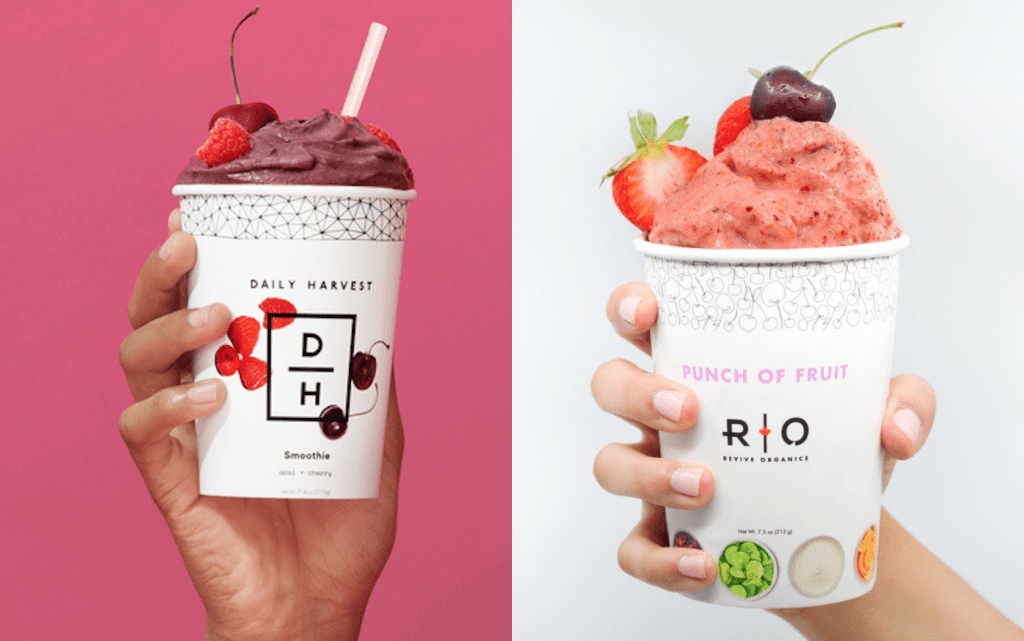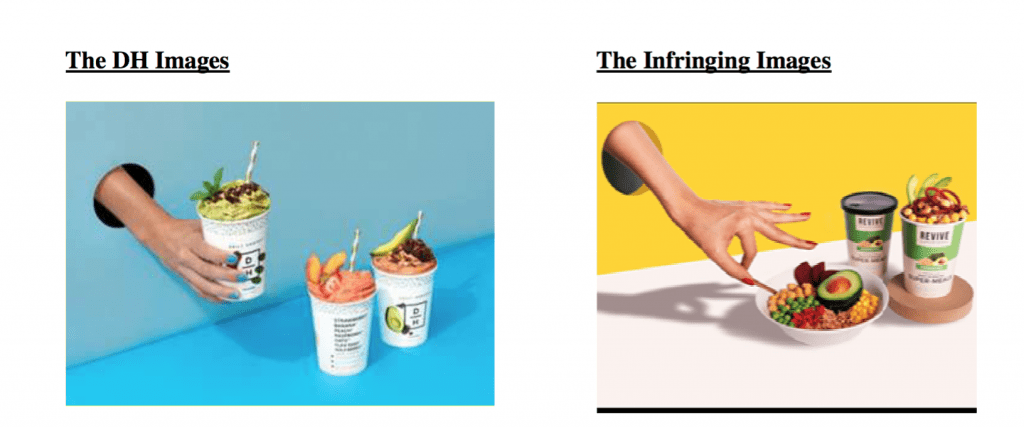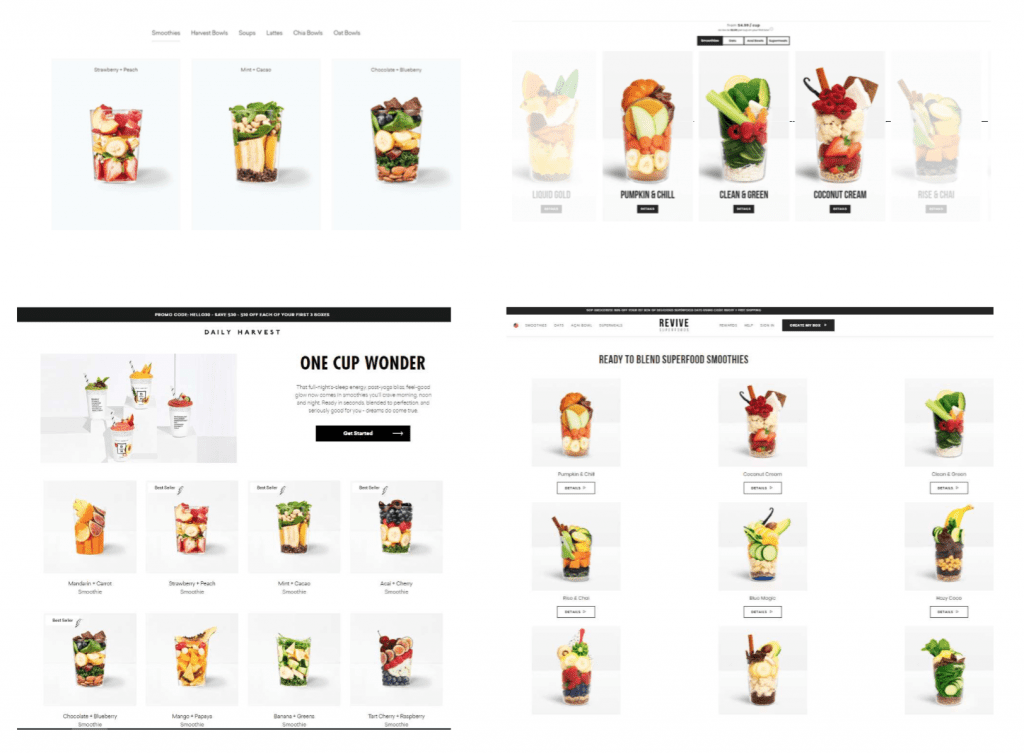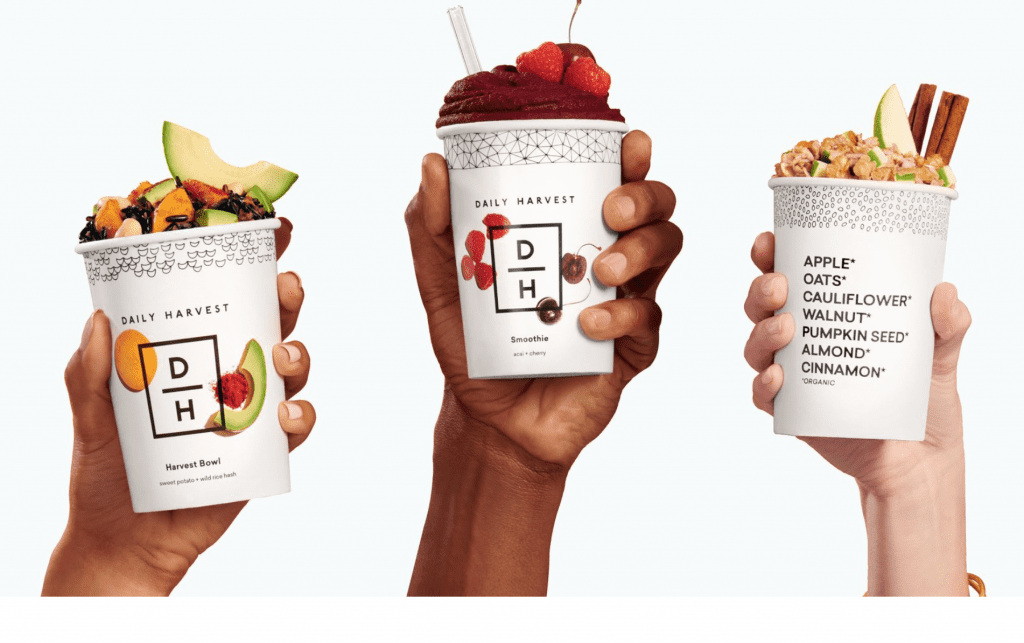In 2015, Rachel Drori set out to start a company that would reimagine the frozen foods space. With Daily Harvest, Drior – a Four Seasons, AMEX, and Gilt Groupe veteran with a background in marketing and branding – aimed to bring “healthy, easy-to-make foods” directly to the consumer’s home, and in the process, she built a buzzy and “rapidly growing” direct-to-consumer (“DTC”) startup, selling over 1 million smoothies, raising $43 million to date from the likes of Bobby Flay, Shaun White, Gwyneth Paltrow and Serena Williams, and winning over fans in search of healthy, convenient eats.
Now, the New York-based company – which says that it has brought in revenue “exceeding $200 million” since 2016 by way of its frozen superfood smoothies, lattes, harvest bowls and soups – is garnering copycats. In the complaint that counsel for Daily Harvest filed in a New York federal court on Thursday, it claims that Revive, a Canada-based frozen food company, looking to expand in the U.S. market, has engaged in a scheme to “free-ride [on] Daily Harvest’s coattails and trade off of [its] reputation.”
Seeking to “receive all the benefits of Daily Harvest’s investments [in its branding and digital presence] without incurring any of the costs,” Daily Harvest asserts that Revive has adopted “an identical and confusingly similar website design, content, product packaging, [and] images.”
Speaking specifically of its own product packaging, Daily Harvest alleges that it has consistently used “unique and inherently distinctive” packaging – namely, contains with “a white background, featuring the two letters DH, displayed in black in the center of the packaging inside a square with a line placed in between the letters D and H, with a black and white geometric-patterned band along the upper rim of the cups, featuring photographs of the product ingredients on the front of the cups, with the ingredients listed on the back of the package in large black font” – to “distinguish [its products] from similar goods offered by others,” thereby, giving rise to trade dress rights. (Trade dress is a subset of trademark law that provides protection for the overall image of a product and/or its packaging, as long as the design has the same source-identifying function as a traditional trademark, such as a logo or word mark).
Beyond its packaging, Daily Harvest asserts that it also maintains trade dress rights in the “look and feel” of its website, as well – from “the home page, [which consists of] a vivid and colorful photograph of a line-up of prepared products topped with garnishes, with a black, rectangular call to action button prompting consumers in white lettering to ‘Get Started’” to “the subpages, [which] feature rows and columns of images of Daily Harvest’s lineup of products.”

Having used such “inherently distinctive” branding consistently since April 2016, Daily Harvest claims that “consumers have come to immediately identify Daily Harvest as the exclusive source of products bearing and/or offered in connection with the trade dress,” whether it be its product packaging or the design of its website.
Against that background, Daily Harvest asserts that “from its inception,” Revive has “sought to unfairly compete with and trade off on [its] established reputation and goodwill by adopting and using a trade dress for its packaging and website that is and/or was confusingly similar to that of [its own].” This includes launching a “competing product line in Canada, using a website that copied – virtually wholesale – the Daily Harvest website, including the user shopping experience and design interface.”
More than that, though, Daily Harvest claims that Revive “adopted packaging that is confusingly and substantially similar to [its] packaging trade dress, consisting of a white background, featuring the two letters RO, displayed in black in the center of the packaging with a line between the letters R and O, with a black geometric-patterned band along the upper rim of the cups, featuring photographs of the product ingredients on the cups, with the ingredients listed on the back of the package in large black font.”
And still yet, Daily Harvest claims that Revive has made use of “photographs that are substantially similar and/or confusingly similar” to the ones that Daily Harvest posts on its website and social media channels, including “a photograph that depicts a ‘look-alike’ model of Ms. Drori, without Ms. Drori’s authorization or consent.” (As a result of Revive’s use of a photo with a lookalike model, Daily Harvest has lodged a New York state right of privacy claim on behalf of Drori).
Despite a back-and-forth between the two companies that has been underway since Daily Harvest sent Revive the first of “several” cease and desist letters in October 2019, in response to which Revive allegedly agreed to make changes to its product packaging and its website, and remove the lookalike photos “by the end of 2019,” Daily Harvest says that Revive has failed to make good on all of its promises.

Daily Harvest claims that Revive has “caused instances of actual confusion” among consumers due to its adoption of a similar website and product packaging, so much so that Daily Harvest says that it has “received communications from disgruntled consumers who mistakenly attempted to use one of [Revive’s] promotional codes to purchase Daily Harvest’s goods and services through the [Daily Harvest] website,” with such “confusion is causing damage to Daily Harvest’s reputation and goodwill as these confused consumers are dissatisfied when Daily Harvest does not honor [Revive’s] promotional codes.”
Interestingly, Daily Harvest – which has set forth claims of trade dress infringement, unfair competition, and violations of New York General Business Law, and is seeking monetary damages and injunctive relief – does not actually claim that Revive copied any of its proprietary products. Instead, the suit firmly centers on what is likely an even more integral element: Revive’s alleged co-opting of the Daily Harvest brand, which seems to suggest that the most valuable – and thus, copy-worthy – elements at play may not be the products, themselves, but something else entirely.
In the DTC space, the products, themselves, certainly are not irrelevant. Consumers swear by Glossier’s Boy Brow, eyebrow-shaping salve, for instance, just as there are die-hard devotees when it comes to Away’s horizontally-lined rolling suitcases, Great Jones’ colorful, enamel finished cookware, and Everlane’s “modern essential” apparel items.
But at the same time, it is difficult to ignore the fact that the distinguishing factor for many of these companies is not earth-shattering, impossible-to-get-elsewhere products. In reality, what is driving much of the success of these entities is more likely carefully-crafted and highly-effective branding and (a sizable amount of) marketing. Glossier’s Instagram-dominating, millennial pink-hued, “no makeup”-makeup messaging, which has been spread by a bevy of cool young things on social media, is a good example of this. As is the “sense of community” around the brand that no shortage of analysts have highlighted as absolutely integral to its success (and which was actually being born from founder Emily Weiss’s beauty blog Into the Gloss, which predates the Glossier venture).
That core emphasis on something other than just-the-product goes similarly applies to Away, as well, whose own co-founder Jen Rubio has said that from the outset, Away’s products have not been the differentiating feature of the company. “The thing that would differentiate us is [the] brand,” she told Eater in 2018.

Speaking about the boom for DTC brands, which largely began two decades ago with the rise of the likes of Warby Parker, Ben Lehrer, Managing Partner of venture firm Lerer Hippeau, all but told Harvard Busiess Review that the product is often secondary, stating, “Back then, it wasn’t too hard to succeed as a smart person with a mediocre product.” What was key, aside from an abundance of venture capital, which enabled big ad-spending and big growth, was these early-movers’ model of “web-only retail, direct distribution, social media marketing, and a specific visual brand identity,” with that element of brand identity being key.
In short: what is oftentimes proving compelling to consumers and driving them to buy is not the suitcase or the lip gloss or the “radically transparent” t-shirts but the brand at play and the messaging that surrounds it, which the brand communicates frequently and directly to the consumer. (Buying into a brand and not just the product is hardly a novel phenomenon when it comes to consumer brands and thus, is why trademarks (i.e., brand names, logos, and other identifiers of source) are so valuable in the first place).
With all of this in mind, it is not surprising that Revive’s alleged scheme to bank on the appeal of Daily Harvest centers almost exclusively on branding-related assets, as opposed to products (although, the products are, generally quite similar, as well). After all, while Daily Harvest’s offerings – which are all “co-designed by a Michelin-trained chef and nutritionist” – are technically at the heart of the company, there is more to Daily Harvest than that.
In other words, the lawsuit at hand drives home the point that a company is about far more than merely its offerings, and those “other” elements – the aesthetically-appealing, Instagram-friendly ones, branding-centric ones – are often what prove attractive to consumers, and also to (alleged) copycats.
In its suit, even Daily Harvest essentially asserts it is not just frozen foods but “distinctive” branding, the layout and content on its website, and the imagery that comes by way of its social media accounts that make Daily Harvest what it is.It is these elements that Daily Harvest says are among its “most important assets,” and that is precisely why they are the very things that its competitor has allegedly replicated.
*The case is Daily Harvest, Inc., and Rachel Drori, v. Revive Organics, Inc., 1:20-cv-03087 (SDNY).











